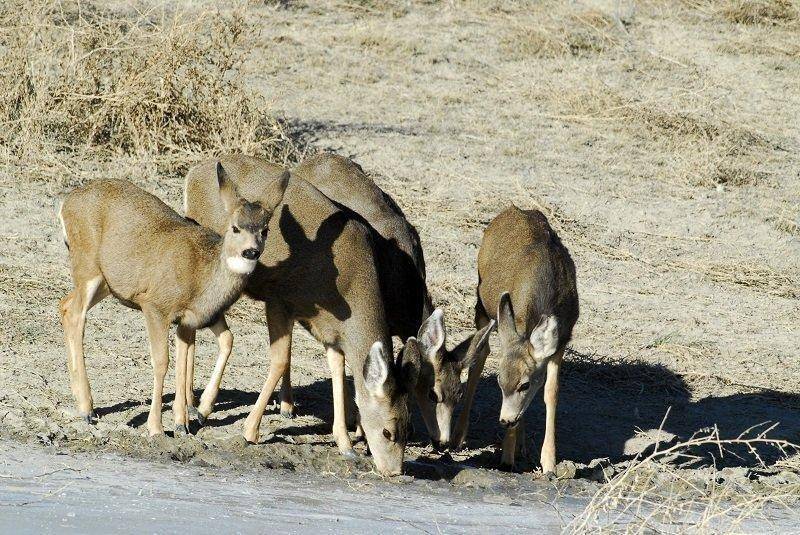Utah Division of Wildlife Resources Press Release
Utah’s deer herds are doing well. Biologists at Utah Division of Wildlife Resources base their hunt recommendations on deer classifications conducted each year. During the classifications, biologists survey deer on their winter ranges to determine how many bucks, does and fawns are in the herds.
What the biologists found during their most recent deer classification, combined with the success general season deer hunters found in fall 2013, paint an encouraging picture. In fact, the success hunters found on general season units this past fall was the best it has been since 2007.
In 2013, a total of 84,600 hunters harvested more than 25,000 bucks on general season units. In 2007, a total of 97,000 hunters harvested about 28,000 bucks on general season units.
After the hunts were over last fall, biologists classified the deer herds to see how many bucks per 100 does were left on general season units. For every 100 does they counted, they also counted an average of 19 bucks.
DWR Big Game Coordinator Justin Shannon says biologists manage 14 of Utah’s 30 general season units for 15 to 17 bucks per 100 does. The remaining 16 units are managed for 18 to 20 bucks per 100 does.
“So, to be at 19 bucks per 100 does is great news for Utah’s hunters,” Shannon indicated. “It means the herds have plenty of bucks in them.”
Based on surveys after last fall’s hunts, biologists estimate the total number of deer in Utah at 332,900. That is only 17,000 deer shy of a short-term, statewide goal of 350,000 deer. This is the most deer in Utah since 2000, when an estimated 322,000 deer were in the state.
Deer studies the DWR started in 2010 also provide encouraging news. Part of the deer studies involved radio collar placement on does and fawns and tracking their survival and reproductive rates.
During the first two years of the study, just over 50 percent of the radio-collared fawns survived an entire year. Over the past two years, however, the annual survival rate has jumped to almost 80 percent.
Does are also producing plenty of fawns. For example, in fall 2012, biologists found an average of 65 fawns per 100 does. That number dropped slightly in fall 2013 to 62 fawns per 100 does, but that ratio is still well within the range needed to help deer numbers grow in Utah.
Shannon says several factors have combined to help Utah’s deer herds and include:
- At the top of the list are mild winters that have allowed deer to survive until the following spring.
- The DWR and its partners have conducted many long-term habitat projects. Those projects are starting to pay off by providing deer with better habitat.
- Highway fencing, underpasses that allow deer to cross safely under roads, predator control and other management actions are helping too.
“We’re really excited, but we still have work to do to reach our goal of 350,000 deer,” Shannon explained. “We will keep moving forward.”
To get an early idea of how many hunters will be hunting big game animals in Utah this fall, a list of DWR biologist recommendations are available at www.wildlife.utah.gov/public_meetings.
After reviewing the ideas, let Regional Advisory Council members know any thoughts or concerns by attending the upcoming southeastern region council meeting or by sending an email to RAC members..
RAC chairs will share the input they receive with members of the Utah Wildlife Board. The board will meet in Salt Lake City on May 1 to approve permit numbers for Utah’s 2014 big game hunts.
The southeastern region council meeting will take place April 9 at 6:30 p.m. at the John Wesley Powell Museum in Green River.
Comments may also be made by email. A list of RAC member email addresses is available at https://wildlife.utah.gov/dwr/rac-members.html. The group each RAC member represents (sportsman, non-consumptive, etc.) is listed under each person’s email address. Correspondence should be directed to the correct RAC member who represents a specific interest.
The following are the total number of permits biologists are recommending compared to last year’s numbers:
Hunt 2013 2014
General buck deer 84,600 84,800
Premium limited entry deer 183 195
Management buck deer 52 49
Limited entry deer 827 811
Doe deer 305 41
General any bull elk 14,300 14,300
General spike bull elk 15,000 15,000
Limited entry bull elk 2,742 2,842
Cow elk 17,817 16,715
Buck pronghorn 841 774
Doe pronghorn 962 669
Bull moose 71 67
Cow moose 0 0
Bison 104 84
Desert bighorn sheep 37 40
Rocky Mountain bighorn sheep 40 38
Mountain goat 162 108

